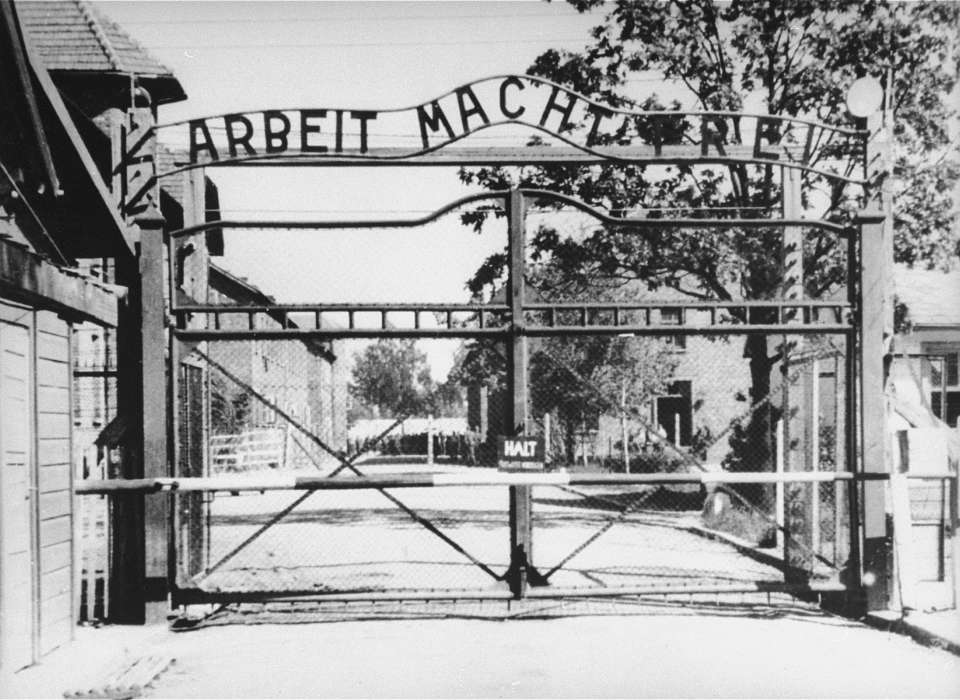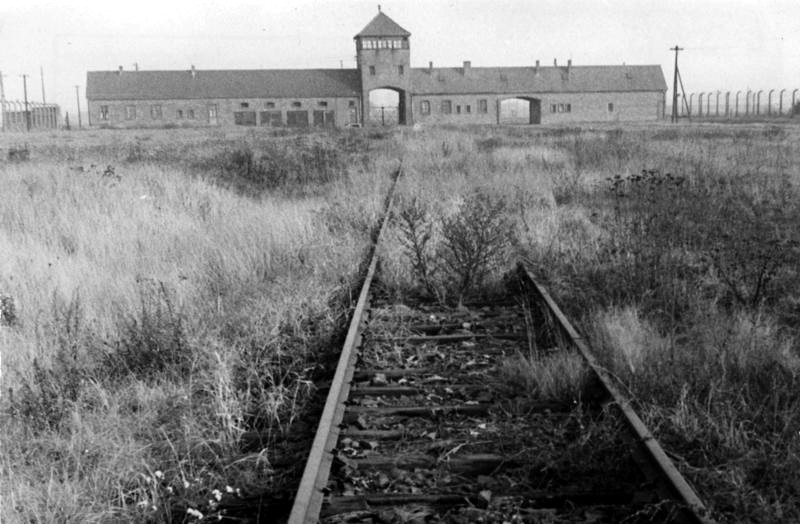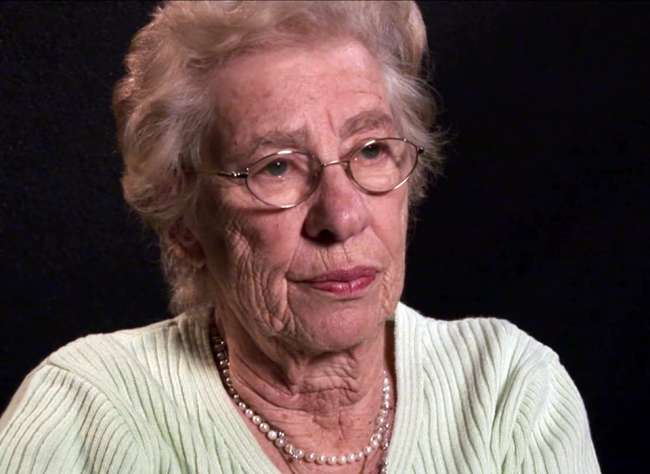Top Photo: View of the entrance to the main camp of Auschwitz (Auschwitz I). The gate bears the motto "Arbeit Macht Frei" (Work makes one free). United States Holocaust Memorial Museum, courtesy of Instytut Pamieci Narodowej
In 2005, the United Nations declared January 27 International Holocaust Remembrance Day. In the resolution, it is stated that every member of the UN should honor the six million Jews as well as those members of other minorities who perished in the Nazi genocide, and to develop educational programs about this history to help prevent such atrocities in the future. Dozens of commemorations are held around the world; speeches are made at the United Nations, in Washington, in Berlin, and in London. Institutions including Yad Vashem in Israel, the Mémorial de la Shoah in France, and the Bundesarchiv in Germany commemorate the victims. Any Auschwitz survivors able to travel to the camp are invited to participate in the very moving and solemn ceremony held on the grounds annually; in 2024, the Auschwitz-Birkenau Memorial and Museum is presenting an exhibition featuring portraits and drawings created by former prisoners of the concentration camp.[1]
It seems self-evident that the Holocaust should be remembered in this way. As Christopher Browning has put it: “I believe that the Holocaust was a watershed event in human history—the most extreme case of genocide that has yet occurred. What distinguishes it from other genocides are two factors: first, the totality and scope of intent—that is, the goal of killing every last Jew, man, woman, and child, throughout the reach of the Nazi empire; and second, the means employed—namely, the harnessing of the administrative/bureaucratic and technological capacities of a modern nation-state and western scientific culture.”[2] Even so, the choice of January 27 is a relatively new phenomenon. How was the date chosen, and why is Auschwitz so important as a symbolic location?
Auschwitz was liberated by the Red Army on January 27, 1945, thanks to the massive Soviet military offensive near Kraków earlier that month. The Soviets did not know about the camp and rather stumbled upon it; as such, there was almost no press coverage of the liberation itself, and it went almost unnoticed. At the time, the world’s attention was focused on the military situation as well as the Yalta Conference during which US President Franklin Delano Roosevelt, Soviet Premier Joseph Stalin, and British Prime Minister Winston Churchill were deciding the outlines of postwar Europe.
The Soviets quickly began to piece together the truth. They learned that only days before their arrival, 56,000 prisoners had been forced by the SS on death marches to the west; around 7,000 prisoners remained in the main three camps of Auschwitz, Monowitz, and Birkenau. Most were emaciated living skeletons eking out an existence in excrement covered barracks; there were people scarred by medical experiments and others too weak to move. The Soviets set up two field hospitals with another brought in by the Red Cross, but for at least 500 inmates, the help came too late. The Soviets were also shocked to find more evidence of appalling Nazi crimes, including huge bags of human hair in large white sacks, 88 pounds of glasses, 44,000 pairs of shoes, thousands of Jewish prayer shawls, myriad cups and bowls, shaving brushes, and over 70,000 men’s suits along with dresses, underwear and baby clothes; they understood, too, that this was just a fraction of what the Nazis had already sorted and shipped to Germany. Soviet filmmakers staged a recreation of the liberation some weeks after the event, with shots of the gates opening along with the now-famous scenes of children dressed in concentration camp uniforms. But the film made little impact at the time, and news of the liberation and findings at the camp were largely ignored internationally. The world was not yet interested in Auschwitz, in part because they did not yet understand what it meant.
At first, the Allies tended to think that all camps were more or less the same. By April, the Western Allies were approaching some of the concentration camps in Germany itself, and on April 5, 1945, Ohrdruf was liberated by American troops. The scenes of piles of dead bodies and starving inmates shocked the troops. General Dwight D. Eisenhower went in person so that he could give firsthand evidence of the crimes, and on April 19 he cabled General George C. Marshall requesting that members of Congress as well as photographers and journalists be brought to Germany to bear witness. The Soviets published a detailed forensic report about Auschwitz at the beginning of May 1945, but again it was overshadowed—this time by the jubilant celebrations marking the end of the war in Europe. Soon, Poland disappeared behind the Iron Curtain, and the day marking the liberation of Auschwitz faded away in the western consciousness.
This was not the case in Poland itself: from the first days of liberation, former inmates were determined to preserve the camp, which became possible in part because so many people actually survived. According to the Auschwitz Memorial Museum, of the 1.3 million people deported to Auschwitz, at least 1.1 million were murdered; tens of thousands survived. By contrast, of the 850,000 Jews murdered in Treblinka, only 70 people survived, and only a handful made it out of extermination camps Bełżec and Chełmno. The Auschwitz survival rate was higher because it was both an extermination camp and a concentration complex consisting of over 40 subcamps. In the largest part of the Auschwitz complex, Auschwitz II-Birkenau, where most of the gas chambers and crematoria were located, there were in the peak time around 90,000 people held in some 300 barracks at one time, and although the death toll was high, many still survived to bear witness. Furthermore, whereas the victims of the Reinhardt Camps had been Jews from occupied Poland, prisoners at Auschwitz came from every corner of Europe, prompting increasing global interest.
The first attempts to preserve the camp took place immediately after liberation when a small group of former prisoners tried to protect the site; one even bribed a Soviet sentry and retrieved the Arbeit Macht Frei sign from an eastbound train. Former inmate Alfred Fiderkiewicz submitted a bill to establish a museum as early as December 1945, which was granted the following year. Over 100,000 people, including many former inmates, came to the first commemoration; the next year drew a group of 170,000. The SS had tried to destroy the archives in the final days of their occupation, but despite their best efforts, around 5 percent of documents survived. At first, these were used to prepare war crime trial cases, including against former Auschwitz commandant Rudolf Höss, but were then returned to become a key part of the memorial. The museum at Auschwitz was officially inaugurated on June 14, 1947.
The creation of the museum was an important milestone, although creating a balanced exhibition proved to be challenging. This was the time of high Stalinism, and Nazism was seen as little more than a radical stage of capitalism; nor did the Soviets recognize the specific genocide of the Jews who were included under the general term “victims of fascism.” The first manifesto excluded specific reference to the Jews altogether, stating that the site was to be “preserved forever as the monument of the martyrdom of the Polish nation and other nations.” Far from commemorating the Holocaust, displays were set up to glorify the solidarity of the international workers movement against the evils of capitalism.
Things changed somewhat during the thaw after Stalin’s death. Kazimierz Smoleń was appointed the new director in 1955 and removed the most blatant Soviet propaganda.[3] Former inmates were invited to help create the core exhibition, which remains very much the same today as it was then. Despite the complications of traveling behind the Iron Curtain, hundreds of thousands of people began to visit the camp from around the world, and yet even by the 1960s, there was no single day of commemoration. In Warsaw, the Jewish community marked the beginning of the Warsaw Ghetto Uprising on April 19; in Israel, official ceremonies were held at Yad Vashem in April, while in Germany the first official commemoration of the Holocaust took place on November 9, 1978—the 40th anniversary of Kristallnacht.
The January date only came to the fore with the 50th anniversary of the end of World War II. Then German President Roman Herzog attended a ceremony at Auschwitz on January 27, 1995, with dignitaries including Polish President Lech Wałęsa and Holocaust survivor Elie Wiesel. In the midst of the widespread celebrations marking the end of the war, Herzog felt that the Holocaust should be remembered in a unique way. He proposed that January 27 become the official day of commemoration of the victims of Nazism, and as such, Germany became the first state to adopt it as an official holiday. In 2000 during a conference in Stockholm, many European leaders, including British Prime Minister Tony Blair and former French President François Mitterrand, agreed that more states should follow in the name of the fight against antisemitism and racism. In 2005, all members of the European Union agreed; the following year, in a resolution cosponsored by 104 member states, UN Secretary-General Kofi Annan designated January 27 as International Holocaust Remembrance Day. The first ceremony took place in the Plenary Hall at the UN Headquarters in New York City in 2006.
There are many places associated with the Holocaust that are often both disturbing and very moving. In Berlin they include the Wannsee Villa, where Nazi officials agreed to the “Final Solution,” as well as the Track 17 monument, which so poignantly documents the train deportations of the Jewish population from Berlin. There are equally moving places in Poland, such as the remains of the extermination camp at Treblinka, which the Nazis destroyed in order to cover up their crimes. Visits to any of these authentic places can be a life-changing experience, and this is particularly true of Auschwitz. While passing beneath the Arbeit Macht Frei gate at the concentration camp at Auschwitz I, or walking across the vast space of Birkenau, past the selection ramp and on toward the crematoria and gas chambers, visitors cannot help but remember the more than 1.1 million innocent human beings who lost their lives in this terrible place. The commemorations on January 27 remind us, too, that the Holocaust was the result of step-by-step decisions by individuals that led to the largest genocide in the history of mankind in a wave of antisemitism, intolerance, and hatred. As such, it remains a profound warning from history.[4]
References:
- [1] For more information on the commemorations visit 79.auschwitz.org; for details on the exhibition see http://lekcja.auschwitz.org/en_18_sztuka/
- [2] Christopher Browning, Nazi Policy, Jewish Workers, German Killers, (Cambridge: CUP 2000) p 32
- [3] Kazimierz Smoleń, Auschwitz 1940-1945, (Katowice: Krajowa Agencja Wydawnicza 1981) p11
- [4] For a general overview of the history of the Auschwitz-Birkenau Museum and Memorial see Auschwitz-Birkenau
Alexandra Richie, DPhil
Alexandra Richie, DPhil, is a historian of Germany and Central and Eastern Europe, with a specialization in defense and security issues.
Cite this article:
MLA Citation:
APA Citation:
Chicago Style Citation:







![Max Fuchs, New York City cantor, sings as Rabbi Sydney [sic] Lefkowitz, Richmond, VA, conducts the first Jewish services from Germany.](/sites/default/files/styles/max_650x650/public/2025-10/image1.jpg)


